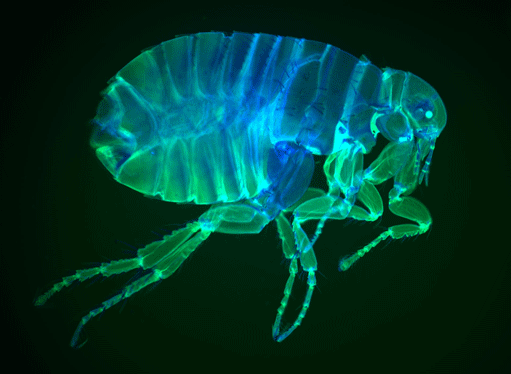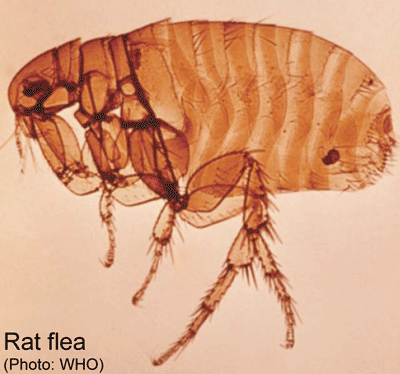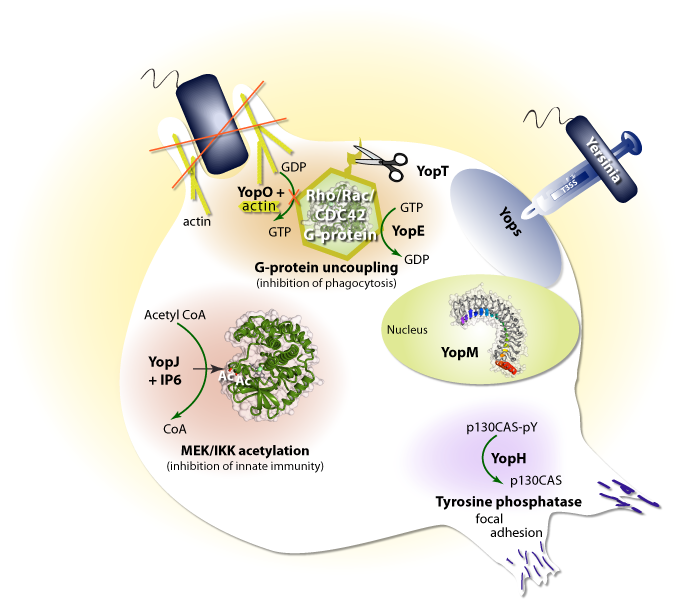How Yersinia bacteria cause disease in humans

Human flea (photo: Brad Amos, MRC-LMB) |
The Black Death was one of the worst natural disasters in history. In 1347 A.D. one third of the population of Europe died as the plague swept through. The first indications of the plague in London was the widespread cases of rats dying in large numbers. They were infected with fleas which carried highly infectious bacteria of the Yersinia species. These fleas can turn to humans as a food source and transmit the bacteria which in turn can infect human fleas and so transmit the disease from human to human. |
 |
Yersinia bacteria multiply in humans and inject toxins into cells, making the host unable to fight the infection (see below). Today antibiotics can kill these bacteria and thus sporadic cases of the plague are rare and will remain thus as long as antibiotic resistant strains do not become prevalent. Currently most cases of human plague are acquired by flea bites, with other cases caused by handling infected animals. |
|
|
Different strains of Yersinia bacteria manifest themselves with different symptoms. Yersinia pestis are bacteria that can infect human lymph nodes which leads to discoloured swelling called buboes (bubonic plague). This infection can spread internally by the bloodstream to the lungs or can enter the lungs through inhalation of bacteria in airborne water droplets (pneumonic plague, which shows rapid mortality). Yersinia pestis can also lead to the black plague where the bacteria enters the victim's blood and causes a septic shock (this form of the disease is alternatively called septicemic plague and shows rapid mortality), where discolouration of the skin is due to coagulation of blood. Another strain, Yersinia entercolitica, enters through the gut and travels to the lymph nodes. |
Yersinia attack cells particularly of the immune system, crippling them by injection toxins right across the cell membrane using an injection apparatus, called a Type III Secretion System. The six toxins injected are called Yops (Yersinia Outer membrane Proteins). |
|
These Yop toxins disable host cells from engulfing the bacteria and digesting them. They also disable an innate immune response of human cells and they also affect cell adhesion. |
Yop Toxins
 |
 |
Our work has uncovered how YopJ disables the innate immune response of human cells allowing the Yersinia to proliferate. |
|
YopJ is primarily responsible for inactivating innate immune responses in macrophages, dendritic cells and neutrophils allowing the bacteria to survive and multiply in the body. This first line of defense is very important in being able to cope with infections and it is of great importance to know how Yersinia can target the appropriate cells and subvert their immune responses. We have discovered how the later activity is controlled by YopJ. |
|
|
|

by Fredrick Morgan |
Ring a Ring O'Roses,
A pocketful of Posies
Atishoo! Atishoo!
We all fall down!
|
It is thought that this children's ditty originates from the time of the plague and explains what was perceived to happen
One of the first symptoms of the plague was a ring of red (rose) coloured spots
A posy of herbs was meant to protect against the disease
The victim sneezes and
falls down (dead) |